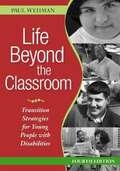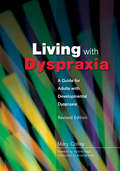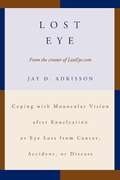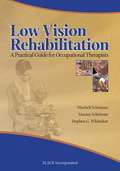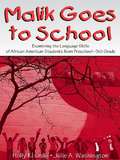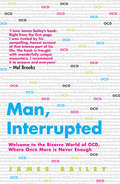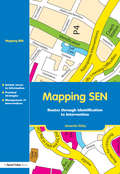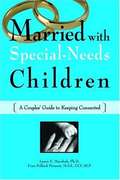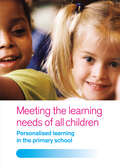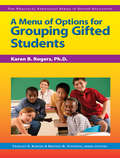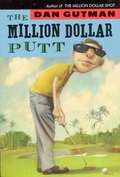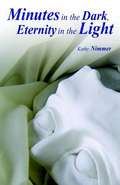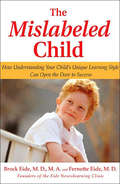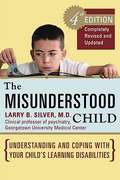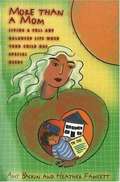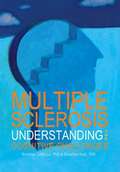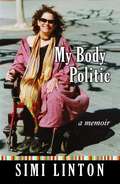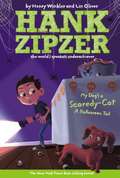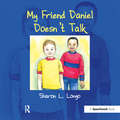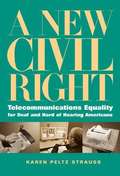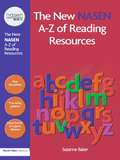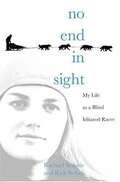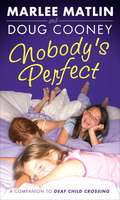- Table View
- List View
A Life after Deafness
by George B. JoslinNovel about a deaf woman escaping from her domineering parents and finding love, marriage, and parenthood.
Life Beyond the Classroom: Transition Strategies for Young People with Disabilities
by Paul WehmanThis classic text, adopted by educators in special and vocational education programs across the country, provides a framework for defining and planning transition, addresses facilitation and support, and discusses ways to individualize transition service delivery for people with specific types of disabilities. Instructors in special and vocational education, and rehabilitation programs love how this text blends theory with practical forms, sample individualized transition plans, and helpful study questions. Photocopiable charts and checklists make it great for the field, as well, so their students will benefit from this text beyond the classroom. The fourth edition is updated with new material on self-determination, inclusion (in schools and the community), high stakes accountability, assistive technology, job carving, social security benefits issues, and application for youth with autism spectrum disorders.
Living with Dyspraxia: A Guide for Adults with Developmental Dyspraxia - Revised Edition
by Amanda Kirby Mary Colley Victoria BiggsFor people with Developmental Dyspraxia, everyday life can pose a multitude of problems. Tasks the majority of people would find simple can often be taxing and fraught with difficulty. Living with Dyspraxia was written to help all adults with Dyspraxia tackle the everyday situations that many people take for granted. It is full of practical advice on everything from getting a diagnosis to learning how to manage household chores. Important topics are addressed, such as self-esteem, whether to disclose your condition within the workplace, how to communicate more effectively and also how Dyspraxia often interacts with other conditions, such as Dyslexia, ADHD and Asperger's Syndrome. This practical resource will be of use to adults with Dyspraxia, the professionals and families members who come into contact with them as well as those who simply wish to learn more about Dyspraxia.
A Look Into Our "i's": A Compilation of Introspective Writings From a Group of Extraordinary Young People With Visual Impairments
by Delta Gamma Center for Children With Visual ImpairmentsStories about how their visual impairments have affected their lives from a dozen teenagers aged 13 to 21.
Lost Eye: Coping with Monocular Vision After Enucleation or Eye Loss from Cancer, Accident, or Disease
by Jay D. AdkissonLost Eye is a collection of e-mails and message threads from Jay Adkisson's LostEye.com website, along with articles and other helpful information to help persons who have lost an eye to cope with the experience. The message is that life can continue as normal after the loss of an eye, and that there are many other people who are similarly situated and have successfully coped with the loss of an eye for many years.
Low Vision Rehabilitation: A Practical Guide for Occupational Therapists
by Mitchell Scheiman Maxine Scheiman Stephen G. WhittakerLow vision rehabilitation is rapidly growing as a specialty practice for occupational therapists. This growth requires practical, evidence-based information on the evaluation and treatment of the effects of low vision on occupational performance. Responding to this need, Low Vision Rehabilitation: A Practical Guide for Occupational Therapists blends standards of practice that have been developed over 50 years by low vision therapists and optometrists, with the latest scientific research and the unique perspective of occupational therapists. Low Vision Rehabilitation presents an emerging model in which occupational therapists practice as part of a team of vision rehabilitation professionals serving adults with low vision. Occupational therapists offer a unique contribution to the vision rehabilitation team, with a focus on meaningful occupational goals, the incorporation of occupation into therapy, and the orchestration of environmental, social, and non-visual personal factors into a treatment plan. Mitchell Scheiman, Maxine Scheiman, and Stephen Whittaker have developed a practical and straightforward text outlining an evaluation approach to interventions that focus on recovering occupational performance in adults. Special features * Incorporates concepts from the AOTA Occupational Therapy Practice Framework: Domain and Process * Provides most of the core knowledge required for the ACVREP low vision certification examination and AOTA specialty certification in low vision * Includes an occupational therapy vision rehabilitation evaluation consisting of four components: occupational profile/case history, evaluation of visual factors, environmental evaluation, evaluation of occupational performance * Emphasizes intervention and low vision rehabilitation treatment including modification of the environment, use of non-optical assistive devices, use of optical devices, and use of computer technology * Provides valuable information on how to start an independent practice in low vision rehabilitation * Includes chapters on diabetic management and electronic assistive technology * Includes access to a companion website with printable forms and additional resources with text purchase Written by authors who are optometrists, occupational therapists, researchers, and certified low vision therapists (CLVT), Low Vision Rehabilitation employs an interdisciplinary perspective that is unique, practical, and credible.
Malik Goes to School: Examining the Language Skills of African American Students From Preschool-5th Grade
by Holly K. Craig Julie A. WashingtonMalik Goes to School: Examining the Language Skills of African American Students From Preschool-5th Grade synthesizes a decade of research by the authors, Holly Craig and Julie Washington, on the oral language and literacy skills of African American children from preschool to fifth grade. Their research has characterized significant influences on the child's use of AAE and the relationship between AAE and aspects of literacy acquisition. The research has also led to the characterization of other nondialectal aspects of language development. The outcome has been a culture-fair, child-centered language evaluation protocol.This very readable volume will be important to students, clinicians, and teachers, learning about and working with, African American children. The book has direct relevance to academic planning, clinical decision-making, curriculum development, and educational policymaking.
Man, Interrupted: Welcome to the Bizarre World of OCD, Where Once More is Never Enough
by James BaileyJames Bailey's form of obsessive-compulsive disorder (OCD) was as bizarre as it was unbearable. He was obsessed by a fear of drugs and their effects, believing himself to be in constant danger of becoming insanely high through people spiking his food, or even by just touching a photograph of a marijuana leaf.The treatment programme he went through at a specialist American clinic was challenging, to say the least. He was asked to shake hands and mingle with the local junkies, fighting his anxieties and the urge to go and wash for as long as possible in order to 'expose' himself to his fears.Man, Interrupted gives us a glimpse into the tortured world of a man suffering from what is an increasingly common disorder. But far from being a doom-laden account of mental illness, the result is uniquely revealing, hilariously entertaining and wonderfully rewarding.
Mapping SEN: Routes through Identification to Intervention
by Amanda KirbyProviding practical guidance on enhancing learning through ICT in English this book is made up of a series of projects that supplement, augment and extend the QCA ICT scheme and provide much-needed links with Units in other subjects’ schemes of work. It includes: fact cards that support each project and clearly outline its benefits in relation to teaching and learningexamples of how activities work in "real" classroomslinks to research, inspection evidence and background reading to support each projectadaptable planning examples and practical ideas provided on accompanying downloadable resources.Suitable for all trainee and practising primary teachers.
Married with Special-Needs Children: A Couples' Guide to Keeping Connected
by Laura E. Marshak Fran P. PrezantMarried with Special-Needs Children is the first book for parents to examine the stress that is often placed upon a marriage when a couple has a child with a disability. Many parents worry that even strong marriages can buckle--and some may break--under the intense demands of raising a child with special needs. In this practical, supportive guide, the authors draw on their combined professional experience in marital counseling and parent training, and feedback from hundreds of parents of children with disabilities who share their solutions and secrets for a healthy relationship.
Meeting the Learning Needs of All Children: Personalised Learning in the Primary School
by Joan DeanPersonalized learning involves helping each child to reach his or her full potential - intellectually, personally and socially. To achieve this, teachers need to match learning opportunities to the learning styles and experiences of the children, taking into account individual differences in culture, language, background, ability and interests.For
A Menu Of Options For Grouping Gifted Students
by Karen B. RogersFrom grouping by ability, to grouping by interest, to grouping by learning style, the use of grouping in the gifted and regular education classroom has proven to be a successful method of instruction for students. Grouping provides teachers with an effective means of providing gifted students with challenging coursework and access to advanced content, and gives students an avenue to create a peer group of other gifted students. Karen B. Rogers, a leader in the field of gifted education, provides teachers with practical advice for choosing a grouping option that best fits their students and information on how to assess their grouping choices. This book gives teachers tips for grouping gifted students in and out of the classroom and provides a menu of options for serving gifted students. This is one of the books in Prufrock Press' popular Practical Strategies Series in Gifted Education. This series offers a unique collection of tightly focused books that provide a concise, practical introduction to important topics concerning the education of gifted children. The guides offer a perfect beginner's introduction to key information about gifted and talented education. Educational Resource
The Million Dollar Putt
by Dan GutmanBlind golfing, anyone? Edward Bogard, Bogie for short, may be blind, but he can learn just about anything he sets his mind to: riding a bike, parasailing, playing guitar. Even though many things come easily to him, he stunned when he hits at a driving range and finds he has the swing of a pro. But blind golfing is a team sport, and Bogie needs a coach. Enter Birdie, the kooky and mysterious girl next door. A bit of a loner, Birdie creates elaborate worlds in miniature in her basement, and has managed to make it to age twelve without learning to ride a bike. Then someone anonymously enters Bogie in a golf tournament with a million dollar prize. If he can team up with Birdie to conquer the greens of Hawaii, could she be the unlikely key to victory?
Minutes in the Dark, Eternity in the Light
by Kathy NimmerThis book contains 140 minute poems: short word pictures of the author's personal journey through vision loss. While every poem is anchored in the theme of blindness, the poems inexplicably rise above that disability label. Many poems are upbeat while others are quite sad. Some share incidents that are well-known by those in his world while others speak of things he has never communicated to another living soul. It is an honest collection of his life experiences tied to the decline of his sight.
The Mislabeled Child: How Understanding Your Child's Unique Learning Style Can Open the Door to Success
by Brock Eide Fernette EideAn incredibly reassuring approach by two physicians who specialize in helping children overcome their difficulties in learning and succeeding in schoolFor parents, teachers, and other professionals seeking practical guidance about ways to help children with learning problems, this book provides a comprehensive look at learning differences ranging from dyslexia to dysgraphia, to attention problems, to giftedness. In The Mislabeled Child, the authors describe how a proper understanding of a child's unique brain-based strengths can be used to overcome many different obstacles to learning. They show how children are often mislabeled with diagnoses that are too broad (ADHD, for instance) or are simply inaccurate. They also explain why medications are often not the best ways to help children who are struggling to learn. The authors guide readers through the morass of commonly used labels and treatments, offering specific suggestions that can be used to help children at school and at home. This book offers extremely empowering information for parents and professionals alike.The Mislabeled Child examines a full spectrum of learning disorders, from dyslexia to giftedness, clarifying the diagnoses and providing resources to help. The Eides explain how a learning disability encompasses more than a behavioral problem; it is also a brain dysfunction that should be treated differently.
The Misunderstood Child, Fourth Edition: Understanding and Coping With Your Child’s Learning Disabilities
by Larry B. SilverThe fully revised and updated must-have resource to help you become a supportive and assertive advocate for your childIn print for more than twenty years, The Misunderstood Child has become the go-to reference guide for families of children with learning disorders. This newly revised edition provides the latest research and new and updated content, including:* How to identify and address specific disabilities, from dyslexia to sensory integration disorder* New information on the genetics of learning disorders* Expanded sections on attention-deficit/hyperactivity disorder (ADHD)* The most recent neurological discoveries about how the brain functions in children with learning disabilities* Insights about other neurological disorders common among individuals with learning disabilities, such as anxiety disorders, obsessive-compulsive behaviors, anger-control problems, depression, and tic disorders* Resources, Web sites, and organizations that can aid the treatment process and offer support for both parent and childFrom the Trade Paperback edition.
More Than a Mom: Living a Full and Balanced Life When Your Child Has Special Needs
by Amy Baskin Heather FawcettSolid, practical advice on how to cope with the many personal challenges mothers of children with disabilities face at home, at work, and within themselves. A "how to" guide for living a balanced, fulfilling life with advice from moms who have been there -- this includes the authors' experiences and insights, and tips from dozens of other moms of kids with special needs who filled out the authors' questionnaire. Jam-packed with useful steps you can take to make your life more manageable, and ultimately more fulfilling. The book addresses 2 main concerns: Taking Care of Yourself (at home physically, emotionally, practically, spiritually/psychically); Taking Care of Business. Target Audience: Mothers of children with developmental disabilities (e.g., Down syndrome, autism, cerebral palsy, etc.) or chronic health concerns.
Multiple Sclerosis: Understanding the Cognitive Challenges
by Nicholas Larocca Rosalind KalbWritten by two clinical psychologists with contributions from two neuropsychologists -- each an MS specialist -- Multiple Sclerosis: Understanding the Cognitive Challenges answers all questions patients may have about their condition, including: A definition of cognition and discussion of the processes that underlie human thought The emotional and social impact of cognitive changes The neuropsychological evaluation of cognitive symptoms Detailed overview of treatment options Vignettes describing the real-life experiences of people with cognitive dysfunction Extensive references to the scientific literature Combining detailed, referenced advice with hands-on strategies for living, this is the only book to provide in-depth information about cognitive dysfunction. It will be an invaluable reference to patients, families, and caregivers, as well as to health professionals who care for people with MS.
My Body Politic: A Memoir
by Simi Linton"I read My Body Politic with admiration, sometimes for the pain that all but wept on the page, again for sheer exuberant friendships, for self-discovery, political imagination, and pluck. . . . Wonderful! In a dark time, a gift of hope. -Daniel Berrigan, S. J. "The struggles, joys, and political awakening of a firecracker of a narrator. . . . Linton has succeeded in creating a life both rich and enviable. With her crackle, irreverence, and intelligence, it's clear that the author would never be willing to settle. . . . Wholly enjoyable. " -Kirkus Reviews "Linton is a passionate guide to a world many outsiders, and even insiders, find difficult to navigate. . . . In this volume, she recounts her personal odyssey, from flower child . . . to disability-rights/human rights activist. " -Publishers Weekly "Witty, original, and political without being politically correct, introducing us to a cast of funny, brave, remarkable characters (including the professional dancer with one leg) who have changed the way that 'walkies' understand disability. By the time Linton tells you about the first time she was dancing in her wheelchair, you will feel like dancing, too. " ---Carol Tavris, author of Anger: The Misunderstood Emotion "This astonishing book has perfect pitch. It is filled with wit and passion. Linton shows us how she learned to 'absorb disability,' and to pilot a new and interesting body. With verve and wonder, she discovers her body's pleasures, hungers, surprises, hurts, strengths, limits, and uses. " -Rosemarie Garland-Thomson, author of Extraordinary Bodies: Figuring Physical Disability in American Culture and Literature "An extraordinarily readable account of life in the fast lane. . . a brilliant autobiography and a great read. " -Sander L. Gilman, author of Fat Boys: A Slim Book While hitchhiking from Boston to Washington, D. C. , in 1971 to protest the war in Vietnam, Simi Linton was involved in a car accident that paralyzed her legs and took the lives of her young husband and her best friend. Her memoir begins with her struggle to regain physical and emotional strength and to resume her life in the world. Then Linton takes us on the road she traveled (with stops in Berkeley, Paris, Havana) and back to her home in Manhattan, as she learns what it means to be a disabled person in America. Linton eventually completed a Ph. D. , remarried, and began teaching at Hunter College. Along the way she became deeply committed to the disability rights movement and to the people she joined forces with. The stories in My Body Politic are populated with richly drawn portraits of Linton's disabled comrades, people of conviction and lusty exuberance who dance, play-and organize--with passion and commitment. My Body Politic begins in the midst of the turmoil over Vietnam and concludes with a meditation on the U. S. involvement in the current war in Iraq and the war's wounded veterans. While a memoir of the author's gradual political awakening, My Body Politic is filled with adventure, celebration, and rock and roll-Salvador Dali, James Brown, and Jimi Hendrix all make cameo appearances. Linton weaves a tale that shows disability to be an ordinary part of the twists and turns of life and, simultaneously, a unique vantage point on the world.
My Dog's a Scaredy-Cat: A Halloween Tail (Hank Zipzer, the World's Greatest Underachiever #10)
by Henry Winkler Lin OliverTeased by the school bully because of his Halloween costume, underachieving Hank, with the help of his friends, exacts revenge by creating the scariest and grossest haunted house ever and inviting the bully to visit.
My Friend Daniel Doesn't Talk
by Sharon LongoWhen outgoing Ryan meets Daniel, a boy who is too afraid to talk in school or other places outside of his home, he befriends the silent boy, defending him in school to the other children. Their friendship grows, and Daniel feels comfortable enough to talk to his new friend. Ryan's tendency to 'talk too much' enables him to help Daniel in the classroom, and he hopes for the day when his friend will be able to talk in school so that the other children may get to know the 'real' Daniel. In the meantime, he is willing to continue to be a friend to Daniel until that day. This beautifully illustrated story book is for children with severe shyness, social anxiety or selective mutism to see that they can make a friend like Ryan. It is also a helpful tool for friends of children like Daniel to understand why these children are unable to talk in certain settings.The theme - of accepting others who are different while trying to emphasise with them - is a universal one, and therefore this book may be enjoyed by all children aged from 4 to 8. While the story should not be read to the class while the child is present or without his or her permission, this book is an invaluable tool for teachers trying to understand selective mutism, and wanting to explain it to their students. For comprehensive advice and information on selective mutism, please see "The Selective Mutism Resource Manual" (Speechmark, 2001). BMA Medical Book Competition Winner Highly Commended in the BMA Patient Information Awards (Printed Materials), "My Friend Daniel Doesn't Talk" really impressed the judges: 'This leaflet has been written by a parent of a child with selective mutism who has written numerous articles on the subject'.'It is written for children to help explain some of the issues around children who 'don't talk' and has been beautifully produced and introduces a sensitive topic via a lovely story about friendship which is a great way to engage with children and inform them about a subject without making it 'an issue' and risk stigmatising a child even more...I loved the illustrations and the characters were portrayed with a gentleness and sensitivity which made the story very likeable. The humour in the story is subtle and effective and unlike many 'stories with a message' written for children, this book is a pleasurable read in its own right, and stands up as a lovely story book, but with the added bonus of including the universal theme of 'being different' and in particular providing a basic explanation for selective mutism. I really loved this book'.'What really came through, is that it was written with real thought, care and from someone who really understands and empathises with the subject matter. Well done!'.
A New Civil Right: Telecommunications Equality for Deaf and Hard of Hearing Americans
by Karen Peltz StraussKaren Peltz Strauss reveals how the paternalism of the hearing-oriented telecommunications industries slowed support for accessible technology for the deaf and hard of hearing users.
The New nasen A-Z of Reading Resources (nasen spotlight)
by Suzanne Baker Lorraine PetersenThe New nasen A-Z of Reading Resources is a graded list of all current reading schemes complete with guidance on the books’ suitability for readers at different levels of experience and competence. It will: enable teachers, SENCos and support services to choose books that are appropriate yet sufficiently rewarding for struggling readers prove to be a time-saving resource for schools replenishing their reading stock follow up-to-the-minute thinking on ‘readability’. A great resource for all schools - primary and secondary - as well as support services, advisers and literacy consultants.
No End In Sight: My Life as a Blind Iditarod Racer
by Rachael Scdoris Rick SteberRachael Scdoris, the daughter of a sled musher, has a passion for sled dogs and racing. From a young age she dreams of racing the Iditarod. Afflicted with a rare eye disorder, she is legally blind but is determined to overcome obstacles to make her dream come true. The book tells of her childhood, her experiences at school, and her struggle to become independent. Her love of dogs and dogsledding are paramount throughout her young life.
Nobody's Perfect
by Marlee Matlin Doug CooneyMegan has spent forever planning her positively purple birthday sleepover. She's even made glittery purple invitations for every girl in her class. Then a new girl, Alexis Powell, joins their class. Alexis seems perfect: She's smart, pretty, and rules the soccer games on the playground. But no matter how hard Megan tries to be a friend to Alexis, the new girl is aloof or rude. At first Megan thinks Alexis is shy. Then Megan starts to fear that Alexis is treating her differently because she's deaf. When the girls are forced to collaborate on a science fair project, Megan learns the truth -- and realizes that nobody's perfect. Once again Marlee Matlin draws on experiences from her own childhood to tell Megan's story. In this funny, poignant book, readers will root for Megan, a spirited young girl who doesn't let anything stand in her way.

